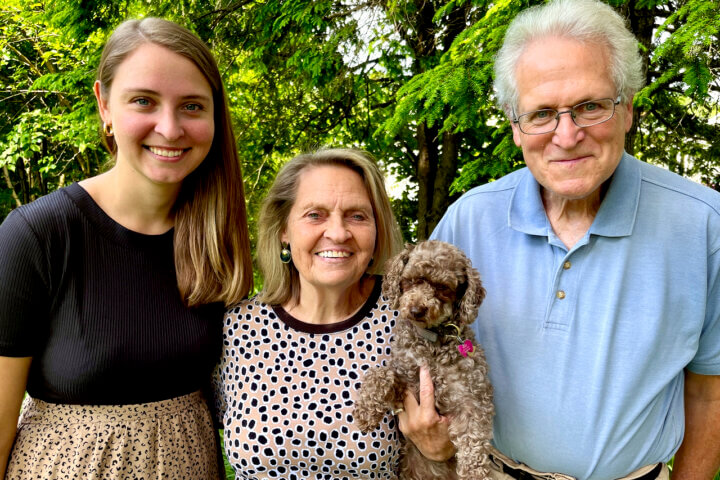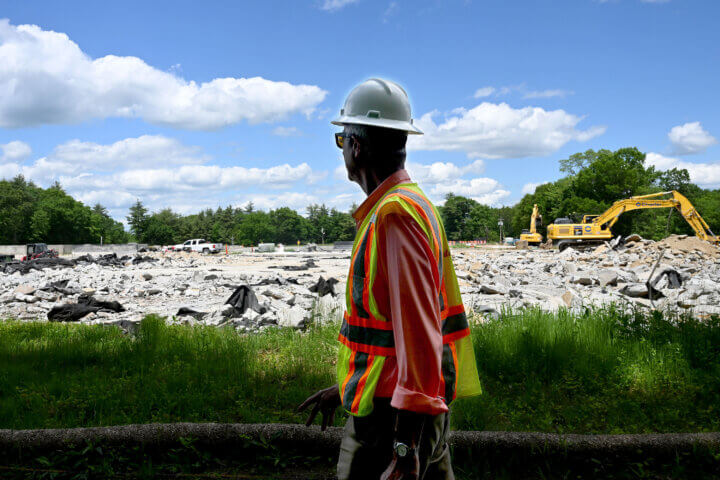By Erin Tiernan — Erin@theconcordbridge.org
Skeptical residents told developers they “don’t buy” claims that a proposal to expand Hanscom airport’s hangar space — mainly for luxury private jets — will have a neutral effect on noise, pollution, and airplane traffic.
At a May 30 public hearing, North Airfield Ventures representatives defended the Draft Environmental Impact Review for a proposed 395,700 square feet of new aircraft parking and storage space.
The plan calls for 17 new hangars and renovation of an existing Navy hangar. State officials must approve the DEIR before North Airfield Ventures can move ahead.
Proponents said the development, which also increases fuel tank capacity and standalone aviation support space, would allow the airport to serve existing clients better and support future growth — all without increasing flight traffic.
“Is that really realistic?” asked Paul Shorb of the Lincoln Green Energy Committee.
Kate Larson of HMMH Aviation Environmental Services, which was hired by North Airfield Ventures to study flight volume, said “growth in the airport will continue with or without the new hangars.”
Larson argued the new hangar space would cut down on so-called “ferry flights.” The developer claims in the DEIR these flights, in which planes are moved for lack of hangar space, make up as much as seven percent of all flights at the airport, or more than 3,200 annually.
She said that sustainable fuel infrastructure, solar panels, and electric charging stations will also help reach emissions targets.

Flight disputes
Ferry flights are central to developers’ claims that the expansion would not increase noise, emissions, or air traffic. They say new hangar space would allow more planes to stay on the ground at Hanscom instead of being “ferried” — flown empty to or from the airport — because of a lack of space to host them.
But the developer-funded analysis of what defines a ferry flight came into question during Thursday night’s public hearing.
“You want to take credit for the possibility of reducing ferry flights. Yet your analysis is so simplistic,” said Scott Richardson of Concord. He was one of only a few dozen people who got to speak out of the roughly 370 who tuned in to the final public hearing before the DEIR public comment period closes on June 14.
Developers canceled the in-person portion of the meeting barely 24 hours before the scheduled start time, citing “safety concerns” over a planned demonstration.
There are no set industry criteria or federal definitions for ferry flights. Analysts hired by North Airfield Ventures created their own criteria to identify ferry flights on Hanscom’s 2022 roster.
In their analysis, ferry flights included business aircraft that were not Hanscom Field tenants. The planes were conducting commercial operations with a ground time of 18 hours or less, with a destination or origin within a 350-mile radius of Hanscom.
The analysis has been refuted by a separate study funded by project opponents Stop Private Jet Expansion at Hanscom and Everywhere.
Their April report found that the project would eliminate only 132 ferry flights but add about 6,000 more regular flights, resulting in 150,000 tons of greenhouse gasses annually.
The average carbon footprint for a person in the United States is 16 tons yearly.
In a separate interview with the Bridge, Hanscom Field Advisory Commission Chairman Chris Eliot called the ferry flights example just one of many instances of “twisted logic” and “self-serving conclusions” that appear in the 273-page DEIR.
The HFAC includes representatives of the four towns that border Hanscom: Concord, Bedford, Lexington, and Lincoln.

In the state’s hands
Climate-focused opponents of private jet travel have latched onto the Hanscom project in their fight to regulate the industry.
When it comes to the Hanscom project, however, state and federal regulatory hurdles will dictate how and when the project moves forward.
Eliot said he hopes to see the Massachusetts Environmental Policy Act Office push back and ask for supplementary reviews on the ferry flights and emissions. Once the DEIR public comment period closes, MEPA has seven days to accept the review or request additional information.
It’s a point Katherine Lee Goyette, staff attorney with Conservation Law Foundation, also makes in her comment on the DEIR.
She argued developers failed to account for the carbon pollution from luxury jets and increased flight operations and called the DEIR’s net-neutral assumptions “incredibly inaccurate.”
“Surrounding communities will have to face much worse environmental and public health threats than the developers are portraying,” Goyette told the Bridge.
“Secretary [Rebecca] Tepper should require developers to file a new analysis that actually considers these additional emissions for the sake of the health and well-being of families who live near the airport.”
MEPA is taking public comment via www.mass.gov/info-details/submitting-comments, and people can also contact the MEPA analyst at alexander.strysky@mass.gov.





